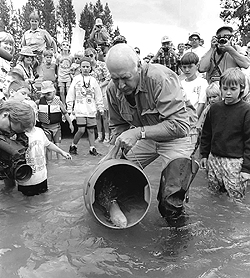forum
library
tutorial
contact

Idaho Poised for Another Big Sockeye Run
by Associated PressThe Olympian, July 21, 2009
|
the film forum library tutorial contact |

|
Idaho Poised for Another Big Sockeye Runby Associated PressThe Olympian, July 21, 2009 |
 BOISE, Idaho - Fish biologists say this year's migration of sockeye salmon to Idaho is on track to be the biggest in decades.
BOISE, Idaho - Fish biologists say this year's migration of sockeye salmon to Idaho is on track to be the biggest in decades.
Through Sunday, federal fish counters have tallied 1,108 endangered sockeye salmon crossing the Lower Granite Dam near Lewiston - the last dam for salmon en route to lakes and streams in central Idaho.
Last year, 907 sockeye crossed the dam, an amount double the combined returns of the previous 23 years. Of those, about 650 made it to the Stanley Basin last summer, with most settling and spawning in Redfish Lake.
Idaho Fish and Game officials are not sure exactly how to explain the back-to-back increases in sockeye numbers.
One factor may be that Idaho is producing more young sockeye in its hatchery program that ultimately swim to the ocean, where they live for two years before returning to Idaho to spawn.
Other positive influences include favorable ocean temperatures and conditions, high river flows that have helped carry smolts to the ocean and changes in hydropower dam management, said Pete Hassemer, anadromous fish manager for Idaho Fish and Game.
"Is one factor or another more responsible for the returns we're seeing the last two years? We can't say for sure," Hassemer said. "But it's important to see that the population is responding to environmental and management changes."
Idaho sockeye were listed as endangered in 1991, one year before just a single male sockeye, dubbed "Lonesome Larry," returned to Redfish Lake.
This year's run is the largest since the eight Columbia and Snake River dams were built and fish counts began in 1975 at Lower Granite Dam. In 1976, Army Corps counters recorded 531 sockeye crossing the dam, the biggest until 2008.
Last year, the run peaked at Lower Granite in early- to mid-July, and the last fish crossed on Oct. 10. After a sockeye crosses Lower Granite, it typically takes about a month before it reaches the Sawtooth Valley. From the ocean, sockeye migrate about 900 miles and swim from sea level to an elevation of 6,500 feet.
learn more on topics covered in the film
see the video
read the script
learn the songs
discussion forum
